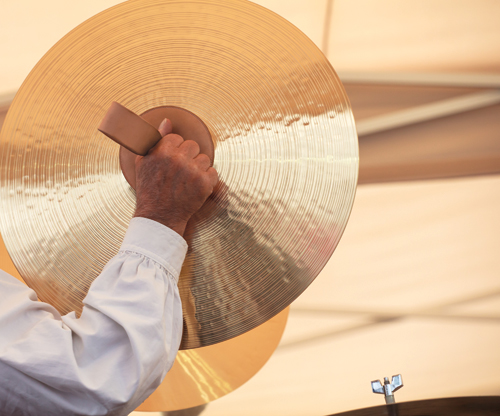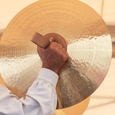
Cymbal crashes are one of the most challenging – and perhaps least understood – concert percussion techniques. Composers frequently write loud, isolated crashes at the climaxes of passages featuring shifting tempo and dynamics, after the student has perhaps been sitting through multiple measures of rest. Players may also be called on to execute repeated soft crashes during the second strain of a march, and these are expected to be subtle, clean, and highly consistent. In both cases, the instruments are heavy, awkward, and prone to erratic physical rebound. Percussionists must develop keen technical control to deliver satisfying musical results.
The multiple facets of crash cymbal performance center around one guiding theme: percussionists should play them, as with all their instruments, in the most natural way possible. Natural does not necessarily mean loose or relaxed; although it could mean both and more, ultimately it means what comes naturally to an individual player. The teacher’s job is to help students recognize what – if anything – is not natural in their technique and to gradually, constantly, and tenaciously weed it out.
Two Exemplars
Two of the best crash cymbal players I ever heard were a percussionist in a major symphony orchestra with which I played several times and a seventh grader I had in concert band as a student teacher. What they had in common was an entirely natural approach to their work. If you could see only their faces as they played, you wouldn’t guess they were doing anything at all. The professional had spent plenty of time polishing his craft and eliminating bad habits and extraneous effort; the student, from what I could gather, was unaware that such problems existed.
Basics
The most basic principles of good crashes are also the main points to check when troubleshooting poor ones. A good crash sound depends on a great deal of vibration from both plates. Cymbal vibrations are easy to see and can be explored by playing a suspended cymbal on its edge with the shoulder of a drumstick. You can make it vibrate quite superficially, producing a thin, high-pitched sound, or quite thoroughly, producing a deeper wash of sound. The latter is generally the desired type of vibration from both cymbals on a loud crash.
This vibration is essentially impossible if the cymbals are held parallel to each other. Guide students to play some crashes with the plates mirroring each other exactly, to illustrate the shallow feeling of contact, insufficient mutual rebound, and entrapment of air inside the pocket. Students should then offset the cymbals slightly vertically and hold them at different angles to avoid these problems. They can gradually change both factors, from mirroring images to asymmetrical positions, while playing successive crashes to see how it works.
No matter the particular technique chosen, problems with cymbal crashes usually result from failure to set up the cymbals in a position conducive to asymmetrical contact, a change of position in mid-motion that undermines the setup, or forcing the instruments to crash instead of letting them do the work.
All of these can be diagnosed by the teacher as the student crashes, or by students themselves if they play in front of a mirror. A brief pause when the student is set for the crash will reveal the precise misalignment and angle planned. Careful attention during the motion and collision of the crash will reveal whether the setup was compromised once initiated. Monitor the upper body, especially from the shoulders down through the fingertips, for any excess tension that may be counteracting a natural, beautiful meeting of the instruments. I like to describe the moment of impact as both cymbals playing each other, rather than one playing the other. Images like this can help students free their technique such that they end up being simply a catalyst, helping the plates deliver their natural response.
When playing soft crashes, the difference in the angle of the cymbals should be less, but the instruments still should not be parallel. The same three considerations apply. The second, maintaining the setup while in motion, becomes especially important when playing repeated crashes as can be found in marches. Setting up and making contact between two cymbals in a purposefully asymmetrical way is jarring at first; repeating it successfully requires focused attention and practice.
Instruments
Our two exemplars also both had great cymbals. The symphonic percussionist’s instruments were much more expensive and somewhat higher in quality than the student’s, but both pairs had a good sound and had been played quite a bit. It is difficult to describe a good cymbal sound, so I advise teachers to listen to many recordings and performances and develop a vivid aural image of how a great crash sounds based on what they hear. Professional symphonic players commonly fall into a particular bread-and-butter position within the percussion section. If you hear the same people playing cymbals in their ensembles regularly, chances are that is their specialty; pay attention.
When purchasing cymbals for your school, visit a store where you can try numerous pairs. If possible, take a percussionist colleague with you. Five pairs of the exact same cymbals will sound five different ways, and only your trained ear will help you choose the ones you want for your students. I have heard pairs of cymbals that neither of our examplars, nor anyone else, could ever sound good playing; I’ve also heard players getting poor sounds no matter how good the cymbals they have, because they have yet to discover how to make the plates work for them. Helping students to explore and refine their most natural technique and putting high-quality instruments in their hands will greatly improve the sound of cymbal crashes in your ensembles.






